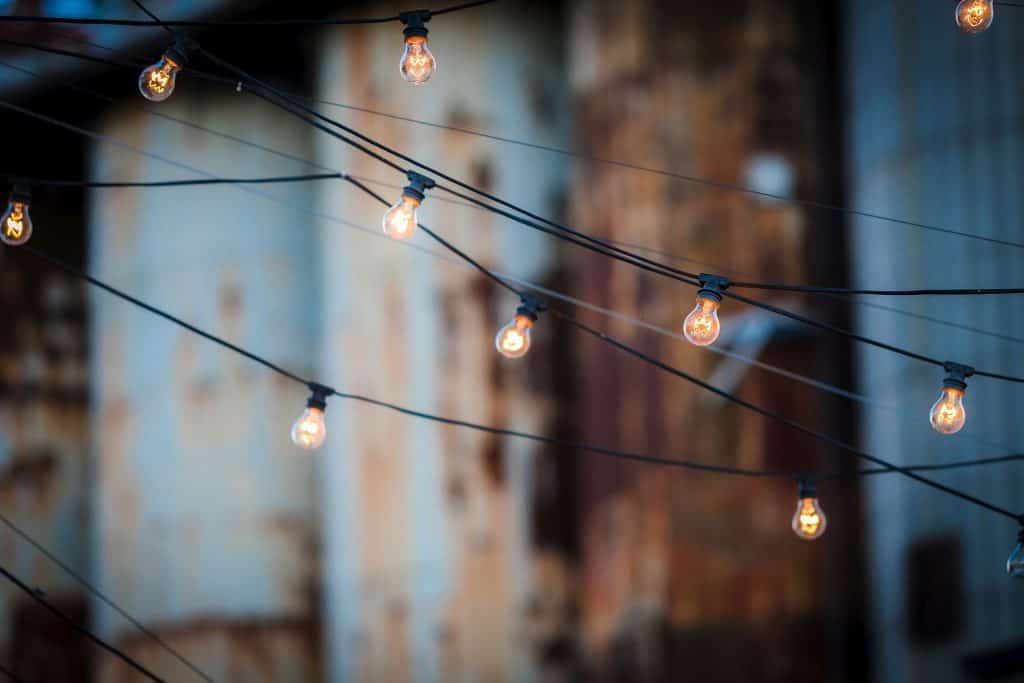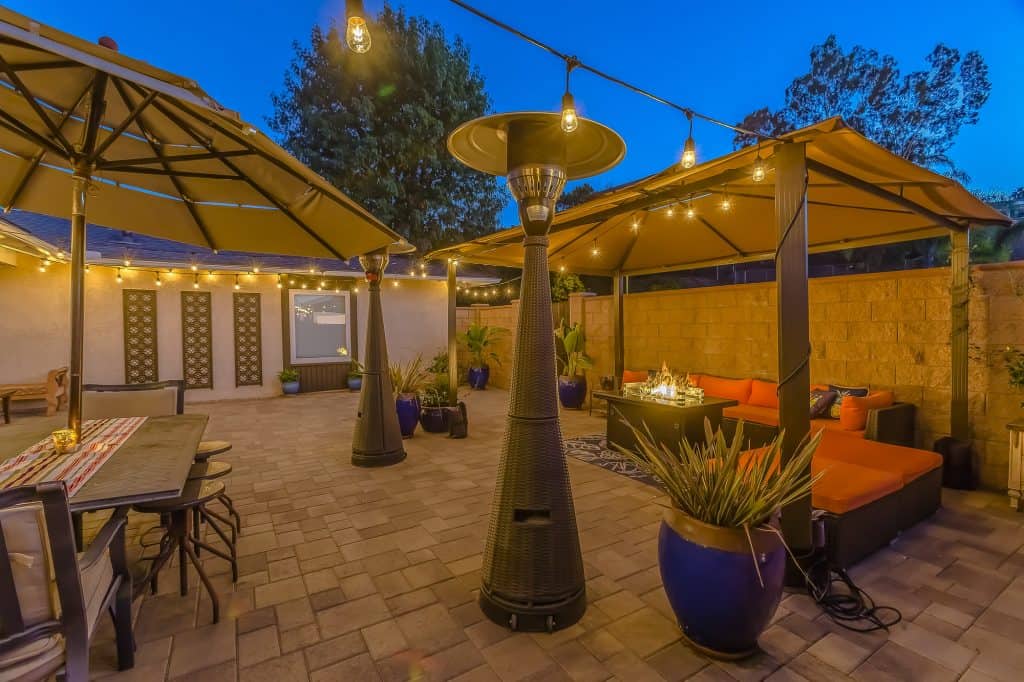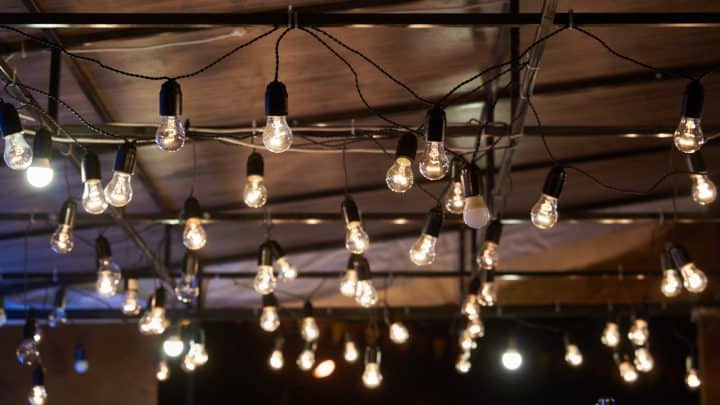Nothing kills the ambiance of an outdoor space like having your outdoor string lights sag too much. Not only is it an eyesore, but you run the risk of catching your head on them as you pass, tearing the entire setup down. Not fun.
While outdoor string lights are simple to install, many people do it incorrectly or cut corners. In fact, even if you’ve hung them perfectly, outdoor string lights have a habit of sagging over time. This is especially true if you didn’t hang them with sagging in mind.
Don’t worry though — the sag is completely fixable!
There are many ways to hang string lights that can help prevent sagging and keep your outdoor space looking its best. We’ll talk about different techniques to control sagging hanging lights, whether you’re hanging them from your house fascia, tree branches, gazeboes, or anywhere else.
Let’s take a look.
1. Try Pulling The Slack
No matter how you’ve hung your string lights, chances are you can remove at least some of the slack just by pulling on the lights. Exerting a small amount of pressure and pulling it slowly can allow you to “redistribute” the slack and reattach the lights accordingly.
This works because the cord on most outdoor lights is designed to be able to stretch at least a little without blistering and breaking. That tolerance for movement is necessary because weather, wind, and even gravity will all force some stretching (no matter how you secure lights outside).
Once you’ve pulled in most of the natural stretch in your outdoor string lights they’re much less likely to stretch further. However, don’t pull it too tight — this can permanently stretch out the wire and cause issues down the line. A little stretch is okay, but too much will cause a costly replacement.
The natural stretch also means that you can often hang string lights a second time and get slightly more length out of them when you hang them again because of the stretch. If you’ve calculated how many feet of string lights you need in the past, it’s possible that you now have too much!
Now, if you’re wondering if you can prevent light strings from stretching in the first place, that’s a great question. We’ll talk more about how to hang patio lights and other outdoor string lights in ways that avoid stretching in the next section.

2. Add Guide Wires
Guide wires are one of the most common suggestions when it comes to how to hang string lights without getting stretched, and to minimize stretching over time. But what are guide wires?
String light guide wires are optional additional wires that help give your string lights a little more support when they’re hanging. However, you need the right gauge wire. If your guide is too thick, it won’t let the string lights flex. When it’s too thin, it won’t provide enough support.
It’s important to make sure you have the right gauge wire when you’re hanging string lights, and that you have the other materials needed to make the guide wires more effective.
What Kind Of Guide Wire Should You Use?
Generally, 304 steel cable is a sufficient gauge for outdoor string lights. It’s strong, relatively lightweight, and comes with vinyl coatings that help disguise the wire and also protect it from the elements.
Attaching Your String Lights To Guide Cables
You can attach your string lights to the guide wire by twisting them around the guide wires and attaching them to hanging points, by using a zip tie, or several zip ties per section of light, to attach them to the guide wire, or other tools. In fact, twine can even work if that’s all you have to work with.
One of the most common methods is using two zip ties at the beginning and end of a section of cord to attach the light strings to the steel cable. You can also use the zip ties to create more loops of string lights attached to the steel cable depending on what look you’re going for.
How To String Guide Cables
There are also two ways to use guide wires. One is to string the guide cable along the same path you want the lights to hang.
This is a good option if you want a firmer attachment and want to limit the amount of stretch and sway in the lights when they hang. It’s also good to add some strength if you’re hanging lights through tree branches, large gaps between connection points, or if you want to protect an extension cord from stretching if you have to use one to provide power.
Usually, if you’re hanging guide cables this way you’ll both twist the lights’ cord around the guide cable and make sure they’re connected with wire clips or zip ties.
However, this method can make it harder to change out light bulbs when they go out, and the cords might mold to the shape of the guide wire, which can make it harder to rearrange if you decide you want to light a different part of your backyard. Using the guidewire is a much more permanent decision.
The other common way to use a guide cable is to attach the cable to your house, deck, or walls, and then hang your string lights from the cable by looping it over the guide cable at specific points.
Again, you’ll want to use clips, zip ties, or other connection points to make sure the string lights are connected and will stay in place.
This makes changing a light bulb a little easier since you usually won’t have to do anything with the guide wires when you need to change the bulbs, but it can let the loop of string lights stretch more.
If you’re looking for lights that sway more naturally, this is a good option, and it also helps preserve more of the natural shape of the sting light’s wiring. However, it can create shorts in the wire faster and allows the cable to stretch more than other kinds of attachments.

3. Attach Directly To The House
Attaching string lights directly to your home, without a guide wire, is another option that can help control stretching and limit the weather damage to the lights.
For instance, you can use an eye hook at all the connection points on your house, but only if you don’t have siding, and there are connection points that are relatively solid. Wire connections and wall pins are other common options.
You don’t want to attach string lights to anything that’s already attached to the home separately. For instance, don’t attach string lights to your gutters because that puts extra stress on the gutters and can pull them down on one end, and just isn’t as secure as connecting directly to your home.
4. Use a String Light Hanging Kit
Here are a couple of string light kits that give you guide wire, connectors, and the other equipment you need to create a secure connection. When you have the right supplies it’s easy to connect string lights and create a beautiful ambiance around your home.
We haven’t yet done a full comparison of all of the options, but can provide a basic recommendation based on our research.
200 ft String Light Hanging Kit with 200ft Black Vinyl-Coated 304 Stainless Steel Cable
This kit comes with a large amount of stainless steel cable, and a variety of connectors for both the guide wire and connecting directly to your home or other structures. The kit’s hardware is designed to be corrosion-resistant, and can all be used to work together to create the exact appearance you want.
You can find more details as well as its many reviews here.
Final Thoughts
Regardless of the technique you choose, it’s not too tricky to fix sagging string lights. The worst-case scenario is that you take them down and rehang, or replace them with new options (if the budget allows). If you have any trouble, let me know in the comments.

